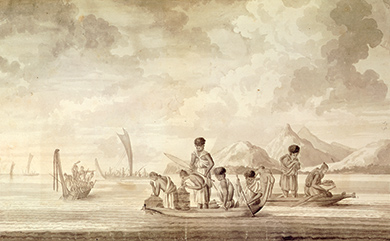Can you imagine?
Introduction
Waka are out in the bay.This often-sunny headland affords long vistas right up Queen Charlotte Sound. Just around the corner is the Grove Arm. You are bound to see some modern waka out on the water today. Can you cast your mind back 400 years, and imagine a different scene?

Huge catches of fish were caught in Queen Charlotte Sound/Tōtaranui, in season, and dried on racks for storage. European visitors to the Sound in the 1840s such as the surveyor John Barnicoat reported welcoming people offering food and shelter and observed huts, fish drying racks, cultivated gardens and people out on the water fishing
Image: British Library ©
Getting about on water is a daily activity. Māori are expert paddlers, both men and women.
Many people are out fishing.
In a few bays near the shore, drifts of smoke rise from campfires. There is a temporary hut being roofed with palm-like branches of nikau. In the bay below you is a drying rack, a wooden structure with fish tied to horizontal sticks.
You hear the thud of adze against tōtara. A great tree is being felled; or is that a waka being formed?
High on a distant hilltop is a burnt patch, indicating the traditional practice of encouraging new bracken fern to grow. The young roots are ground for food to bake in the hāngī/oven.
At another time of the year you see no human activity; the silence of the place broken only by the ka-ka-ka call of a kākā on its wide ranging journey across densely forested hills. The mists have come down, enveloping you in visual isolation. Or the people are simply not here. They are away gathering food elsewhere, or socialising at one of the larger villages in another part of Te Tau Ihu O Te Waka.
